Atoms and Molecules Class 9 Extra Questions Science Chapter 3
Extra Questions for Class 9 Science Chapter 3 Atoms and Molecules
Atoms and Molecules Class 9 Extra Questions Very Short Answer Questions
Question 1.
Name two scientists who established the laws of chemical combination?
Answer:
Antoine L. Lavoiser and Joseph L. Proust.
Question 2.
Give an example of a triatomic molecule of an element.
Answer:
Ozone (O3)
Question 3.
Define atomicity.
Answer:
It is the number of atoms present in one molecule of a substance.
Question 4.
Write the atomicity of the following molecules:
(i) Sulphur
(ii) Phosphorus
Answer:
(i) 8
(ii) 4
Question 5.
What is an ion? Give one example.
Answer:
The negatively and positively charged particles are called ions.
For example: Cl– , Br– , \(\mathrm{SO}_{4}^{2-}, \mathrm{PO}_{4}^{3-}\),H+, Pb+ , etc.
Question 6.
Give one word for the following:
(i) A group of atoms carrying a charge
(ii) Positively charged ion
Answer:
(i) Ion
(ii) Cation
Question 7.
The atomic number of three elements A, B and C are 9, 10 and 13 respectively. Which of them will form a cation?
Answer:
Electronic configuration of A : 2, 7
Electronic configuration of B : 2, 8
Electronic configuration of C : 2, 8, 3
‘C’ will form a cation because a cation is formed by the loss of one or more electrons by an atom.
Question 8.
What is wrong in saying ‘one mole of nitrogen’?
Answer:
The statement does not clarify whether we are talking about atoms or molecules of nitrogen. We should say ‘one mole of nitrogen atoms’ or ‘one mole of nitrogen molecule’.
Question 9.
‘Dalton’s atomic theory is contradicted by the formula of sucrose (C12H22O11).’ Justify the statement.
Answer:
Dalton’s atomic theory states that atoms of different elements combine together in simple whole number ratio. In the formula of C12H22O11 the carbon, hydrogen and oxygen combine in whole number ratio but the ratio is not simple.
Question 10.
How many times heavier is one atom of carbon than one atom of oxygen?
Answer:
Atomic mass of carbon = 12 u
Atomic mass of oxygen = 16 u
Therefore, one atom of carbon is \(\frac{12 u}{16 u}=\frac{3}{4}\) times heavier than one atom of oxygen.
Atoms and Molecules Class 9 Extra Questions Short Answer Questions-I
Question 1.
Give an example to show law of conservation of mass applies to physical changes also.
Answer:
Law of conservation of mass states that mass can neither be created nor destroyed in a chemical reaction. However, this law applies to physical changes also. For example, when ice melts into water, the mass of ice equals to the mass of water, i.e., the mass is conserved. This verifies the law of conservation of mass.
Question 2.
Which of the following symbols of elements are incorrect? Give their correct symbols.
(a) Cobalt CO
(b) Carbon c
(c) Aluminium AL
(d) Helium He
(e) Sodium So [NCERT Exemplar]
Answer:
(a) Incorrect, the correct symbol of cobalt is Co.
(b) Incorrect, the correct symbol of carbon is C.
(c) Incorrect, the correct symbol of aluminium is Al.
(d) Correct (He)
(e) Incorrect, the correct symbol of sodium is Na.
Question 3.
Which of the following are tri-atomic and tetra-atomic molecules?
CH3Cl, CaCl2, NH3, PCl3, P2O5, H2O, C2H5OH
Answer:
(i) Tri-atomic molecules are CaCl2, H2O.
(ii) Tetra-atomic molecules are NH3, PCl3.
Question 4.
Differentiate between the actual mass of a molecule and gram molecular mass.
Answer:
Actual mass of a molecule is obtained by dividing the molar mass by Avogadro’s number whereas gram molecular mass represents the molecular mass expressed in grams, i.e., it is the mass of 1 mole of molecules, i.e., Avogadro’s number of molecules.
Question 5.
Calculate the formula mass of sodium carbonate (Na2CO3.10H2O).
Answer:
Formula mass of sodium carbonate
= (2 × atomic mass of Na) + (1 × atomic mass of C) + (3 × atomic mass of O) + 10 [(2 × atomic mass of H) + (1 × atomic mass of O)]
= 2 × 23 + 1 × 12 + 3 × 16 + 10 [(2 × 1) + (1 × 16)]
= 46 + 12 + 48 + 180 = 286 u
Question 6.
Calculate the mass of one atom of hydrogen atom.
Answer:
1 mole of hydrogen atom = 1 g
or 6.022 × 1023 atoms of hydrogen weigh = 1 g
Mass of one atom = \(\frac{1}{6.022 \times 10^{23}}\)g
= 1.66058 × 10-24g
Question 7.
How many moles are present in 4 g of sodium hydroxide?
Answer:
Gram molar mass of NaOH = 23 + 16 + 1 = 40 g
40 g of NaOH = 1 mol
∴ lg of NaOH = \(\frac{1}{40}\)mol
∴ 4 g of NaOH = \(\frac{1}{40}\) × 4 mol = 0.1 mol
Question 8.
A sample of ammonia weighs 3.00 g. What mass of sulphur trioxide contains the same number of molecules as are in 3.00 g ammonia?
Answer:
Number of moles of ammonia in 3.00 g = \(\frac{3.00}{17}\) mol
= 0.1764 mol
Molecular mass of S03 = 1 × 32u + 3 × 16u = 80u
1 mole of SO3 weighs 80 g
∴ 0.1764 moles weigh = 80 × 0.1764 g
= 14.11 g
Question 9.
Carbon dioxide produced by action of dilute hydrochloric acid on potassium hydrogen carbonate is moist whereas that produced by heating potassium hydrogen carbonate is dry. What would be the difference in the composition of carbon dioxide in the two cases? State the associated law.
Answer:
The composition of CO2 in both the cases would be same, i.e., the carbon and oxygen will combine in the same ratio 1 : 2.
The law associated is law of constant proportion.
Question 10.
How many atoms would be present in a black dot marked on the paper with graphite pencil as a full stop at the end of a sentence. [Given mass of a dot = 10-18 g]
Answer:
1 mole of carbon atoms weigh = 12 g
Also, 1 mole of carbon atoms = 6.0 2 2 × 1023 atoms
Thus, 12 g of carbon atoms has 6.022 × 1023 atoms.
∴ 10-18 g of carbon will have \(\frac{6.022 \times 10^{23}}{12} \times 10^{-18}\) × 10-18 carbon atoms
= 5.02 × 104 carbon atoms.
Question 11.
Does the solubility of a substance change with temperature? Explain with the help of an example. [NCERT Exemplar]
Answer:
Yes, it is a temperature dependent property. The solubility generally, increases with increase in temperature. For example, you can dissolve more sugar in hot water than in cold water.
Atoms and Molecules Class 9 Extra Questions Short Answer Questions-II
Question 1.
Write the cations and anions present (if any) in the following compounds:
(a) CH3COONa
(b) NaCl
(c) H2
(d) NH4NO3
Answer:
Anions Cations
(a) CH3COO– Na+
(b) Cl– Na+
(c) H2—It is a covalent compound
(d) \(\mathrm{NO}_{3}^{-}\) \(\mathrm{NH}_{4}^{+}\)
Question 2.
Calculate the mass percentage of oxygen present in the following compounds and state the law of chemical combination associated. Given, H = 1, O = 16.
(i) Water (H2O) and
(ii) Hydrogen peroxide (H2O2)
Answer:
According to Law of multiple proportions
(i) H2O % of O = \(\frac{16}{18}\) × 100 = 88.89%
(ii) H2O2, % of O = \(\frac{32}{34}\) × 100 = 94.12%
Question 3.
Classify each of the following on the basis of their atomicity.
(a) F2
(b) NO2
(c) \(\mathrm{CO}_{3}^{2-}\)
(d) C2H6
(e) CO
(f) H2O2
(g) P4O10
(h) O3
(i) HCl
(j) CH4
(k) He
(l) Ag [NCERT Exemplar]
Answer:
(a) 2
(b) 3
(c) 4
(d) 8
(e) 2
(f) 4
(g) 14
(h)3
(i) 2
(j)5
(k) 1 (Noble gases do not combine and exist as monoatomic gases)
(l) Polyatomic: It is difficult to talk about the atomicity of metals as any measurable quantity will contain millions of atoms bound by metallic bond.
Question 4.
Calculate the molecular mass of the following:
(a) H2CO3
(b) C2H5OH
(C) MgSO4
Answer:
(a) Molecular mass of H2CO3 = 2 × 1 + 1 × 12 + 3 × 16
= 2 + 12 + 48
= 62 u
(b) Molecular mass of C2H5OH = 2 × 12 + 5 × 1 + 1 × 16 + 1
= 24 + 5 + 16 + 1
= 46 u
(c) Molecular mass of MgSO4 =1 × 24 + 1 × 32 + 4 × 16
= 24 + 32 + 64
= 120 u
Question 5.
What are ionic and molecular compounds? Give examples. [NCERT Exemplar]
Answer:
Atoms of different elements join together in definite proportions to form molecules of compounds. For example, water, ammonia, carbon dioxide. Compounds composed of metals and non-metals contain charged species. The charged species are known as ions. An ion is a charged particle and can be negatively or positively charged. A negatively charged ion is called an anion and the positively charged ion is called cation. For example, sodium chloride, calcium oxide.
Question 6.
Give three significance of mole.
Answer:
- One mole represents 6.022 × 1023 entities of a substance.
- One mole of an element contains 6.022 × 1023 atoms of the element.
- One mole of a substance represents one gram formula mass of the substance.
Question 7.
How many (a) molecules (b) hydrogen atoms (c) oxygen atoms are there in 0.5 mol of water?
Answer:
(a) 1 mol of water contains 6.022 × 1023 molecules
∴ 0.5 mol of water contains \(\frac{6.022 \times 10^{23}}{2}\) molecules
= 3.011 × 1023 molecules
(b) 1 molecule of water contains 2 atoms of hydrogen
1 mol of water contains 2 × 6.022 × 1023 atoms of hydrogen
∴ 0.5 mol of water contains \(\frac{2 \times 6.022 \times 10^{23}}{2}\) atoms of hydrogen
= 6.022 × 1023 atoms of hydrogen
(c) 1 molecule of water contains 1 atom of oxygen
1 mol of water contains 6.022 × 1023 atoms of oxygen
∴ 0.5 mol of water contains \(\frac{6.022 \times 10^{23}}{2}\) atoms of oxygen
= 3.011 × 1023 atoms of oxygen
Question 8.
Calculate the number of moles present in:
(i) 3.011 × 1023 number of oxygen atoms.
(it) 60 g of calcium
[Given that atomic mass of Ca = 40 u, Avogadro No. = 6.022 × 1023]
Answer:
(i) 1 mole of oxygen contains 6.022 × 1023 atoms
∴ 6.022 × 1023 atoms of oxygen = 1 mol
1 atom of oxygen = \(\frac{1}{6.022 \times 10^{23}}\) mol
∴ 3.011 × 1023 atoms of oxygen = \(\frac{1 \times 3.011 \times 10^{23}}{6.022 \times 10^{23}}\) mol
= 0.5 mol
(ii) Atomic mass of Ca = 40 u
40g of calcium = 1 mol
60g of calcium = \(\frac{60}{40}\) mol =1.5 mol
Question 9.
Calculate the mass per cent of each element of sodium chloride in one mole of it.
Answer:
Molecular mass of NaCl = (1 × 23 + 1 × 35.5) u = 58.5 u
Atomic mass of sodium = 23 u
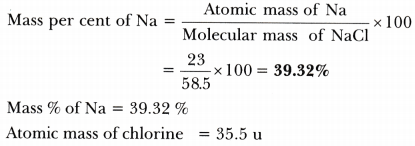

Question 10.
Calculate the number of particles in each of the following:
(a) 46 g of Na atom
(b) 8 g of O2 molecules
(c) 0.1 moles of carbon atom
Answer:
(a) No. of moles of sodium = \(\frac{46}{23}\) = 2 moles
We know that one mole of sodium contains 6.022 × 1023 atoms.
∴ 2 moles of sodium contain = 2 × 6.022 × 1023 atoms
= 1.204 × 1024 atoms
(b) 1 mole of oxygen = 32 g
32 g of 02 contains 6.02 2 × 1023 molecules
∴ 8 g of O2 contains = \(\frac{6.022 \times 10^{23}}{32}\) × 8 molecules
= 1.51 × 1023 molecules
(c) 1 mole of carbon atoms contains 6.022 × 1023 atoms
∴ 0.1 mole of carbon atoms contains = 6.022 × 1023 × 0.1 atoms
= 6.022 × 1022 atoms
Question 11.
Raunak took 5 moles of carbon atoms in a container and Krish also took 5 moles of sodium atoms in another container of same weight. [NCERT Exemplar]
(a) Whose container is heavier?
(b) Whose container has more number of atoms?
Answer:
(a) Mass of sodium atoms carried by Krish = (5 × 23) g = 115 g
Mass of carbon atoms carried by Raunak = (5 × 12) g = 60 g
Thus, Krish’s container is heavier.
(b) Both the bags have same number of atoms as they have same number of moles of atoms.
Atoms and Molecules Class 9 Extra Questions Long Answer Questions
Question 1.
Arrange the following in order of decreasing masses:
(i) 1023 molecules of CO2 gas
(ii) 0.1 g atom of silver
(iii) 1 gram of carbon
(iv) 0.1 mole of H2SO4
(v) 1023 atoms of calcium.
(Given Atomic masses: Ag = 108 u, S = 32 u, N = 14 u, Ca = 40 u)
Answer:
(i) 1 mole of CO2= 44 g = 6.02 × 1023 molecules
i.e., 6.02 × 1023 molecules of CO2 = 44 g of CO2
1023 molecules of CO2 = \(\frac{44}{6.02 \times 10^{23}}\) × 1023 = 7.31 g
(ii) 1 g atom of Ag = Gram atomic mass of Ag = 108 g
∴ 0.1 g atom of Ag = 0.1 × 108 g = 10.8 g
(iii) 1 g of carbon = 1 g
(iv) 1 mole of H2SO4 = Gram molecular mass
= 2 × 1 + 32 + 4 × 16 = 98 g
∴ 0.1 mole of H2SO4 = 0.1 × 98 g = 9.8 g
(v) 1 mole of Ca = 40 g = 6.02 × 1023 atoms of Ca
i.e., 6.02 × 1023 atoms of Ca have mass = 40 g
∴ 1023 atoms of Ca have mass = \(\frac{40}{6.02 \times 10^{23}}\) × 1023 = 6.64 g
Thus, masses in the decreasing order are: 0.1 g atom of Ag > 0.1 mole of H2SO4 > 1023 molecules of CO2 > 1023 atoms of Ca > 1 g of carbon
Question 2.
Calculate the number of aluminium ions (Al3+) in 0.056 g of alumina (Al2O3).
Answer:
Molecular mass of alumina (Al2O3) = 2 × Al3+ + 3 × O2-
= 2 × 27 u + 3 × 16 u
= 102 u
Gram molecular mass = 102 g
1 mol of alumina (Al2O3) = 102 g
102 g of Al2O3 = 1 mol
∴ 0.056 g of Al2O3 = \(\frac{1 \times 0.056}{102}\) mol
= 5.49 × 10-4 mol
We know that one mol of alumina contains 2 mol of Al3+ ions.
∴ 5.49 × 10-4 mol of Al2O3 contains 2 × 5.49 × 10-4 mol of Al3+ ions
∴Number of Al3+ ions in 0.056 g = 2 × 5.49 × 10-4 × 6.022 × 1023
= 6.613 × 1020 ions of Al3+
Question 3.
Calculate the mass per cent of each element present in the molecule of calcium carbonate.
Answer:
Molecular formula of calcium carbonate = CaCO3
Molecular mass of CaCO3 = 1 × Ca + 1 × C + 3 × O
= 1 × 40u + 1 × 12u + 3 × 16u = 100u
Gram molecular mass =100 g/mol
1 mol of CaC03 = 100 g
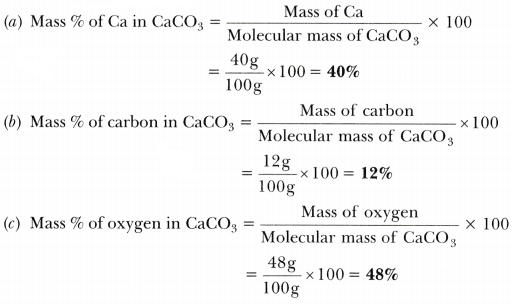
Question 4.
Verify by calculating that
(a) 5 moles of CO2 and 5 moles of H20 do not have the same mass.
(b) 240 g of calcium and 240 g of magnesium elements have a mole ratio of 3 : 5. [NCERT Exemplar]
Answer:
(a) CO2 has molar mass = 44 g mol-1
5 moles of CO2 have molar mass = 44 × 5 = 220 g
H2O has molar mass = 18 g mol-1
5 moles of H2O have mass = 18 × 5g = 90g
(b) Number of moles in 240 g Ca metal = \(\frac{240}{40}\) = 6
Number of moles in 240 g of Mg metal = \(\frac{240}{40}\) = 10
Ratio is 6 : 10
or, 3 : 5
Question 5.
Find the ratio of mass of the combining elements in the following compounds:
(a) CaCO3
(b) MgCl2
(c) H2SO4
(d) C2H5OH
(e) NH3
(f) Ca(OH)2
Answer:
(a) CaCO3
Ca : C : O × 3
40 : 12 : 16 × 3
40 : 12 : 48
10 : 3 : 12
(b) MgCl2
Mg : Cl × 2
24 : 35.5 × 2
24 : 71
(c) H2SO4
H × 2 : S : O × 4
1 × 2 : 32 : 16 × 4
2 : 32 : 64
1 : 16 : 32
(d) C2H5OH
C × 2 : H × 6 : O
12 × 2 : 1 × 6 : 16
24 : 6 : 16
12 : 3 : 8
(e) NH3
N : H × 3
14 : 1 × 3
14 : 3
(f) Ca(OH)2
Ca : O × 2 : H × 2
40 : 16 × 2 : 1 × 2
40 : 32 : 2
20 : 16 : 1
Question 6.
Calcium chloride when dissolved in water dissociates into its ions according to the following equation.
CaCl2 (aq) → Ca2+ (aq) + 2Cl– (aq)
Calculate the number of ions obtained from CaCl2 when 222 g of it is dissolved in water. [NCERT Exemplar]
Answer:
1 mole of calcium chloride = 111 g
∴ 222 g of CaCl2 is equivalent to 2 moles of CaCl2
Since 1 formula unit CaCl2 gives 3 ions, therefore, 1 mole of CaCl2 will give 3 moles of ions.
2 moles of CaCl2 would give 3 × 2 = 6 moles of ions.
Number of ions = Number of moles of ions × Avogadro number
= 6 × 6.022 × 1023
= 36.132 × 1023
= 3.6132 × 1024 ions.
Question 7.
What is a mole? What is the unit of mole? How many molecules are there in a certain mass of a substance?
Answer:
A mole is the amount of a substance which contains the same number of chemical units (atoms, molecules or ions) as there are atoms in exactly 12 g of carbon-12. The unit of mole is given by the symbol ‘mol’.
We know that Avogadro number is 6.022 × 1023
Number of molecules in a certain mass

where ‘W is the mass of the substance in which number of molecules is to be calculated and ‘M’ is the molecular mass of the substance.
Question 8.
The difference in the mass of 100 moles each of sodium atoms and sodium ions is 5.48002 g. Compute the mass of an electron. [NCERT Exemplar]
Answer:
A sodium atom and ion differ by one electron. For 100 moles each of sodium atoms and ions there would be a difference of 100 moles of electrons.
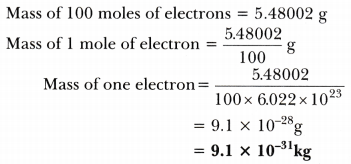
Question 9.
The mass of one steel screw is 4.1 lg. Find the mass of one mole of these steel screws. Compare this value with the mass of the Earth (5.98 × 1024 kg). Which one of the two is heavier and by how many times? [NCERT Exemplar]
Answer:
1 mole of steel screws = 6.022 × 1023 screws
Mass of 1 screw = 4.11 g
∴ Mass of 1 mole of screws = 4.11 × 6.022 × 1023 g
= 24.75 × 1023 g = 2.475 × 1024 g
One mole of screw weighs = 2.475 × 1024 g = 2.475 × 1021 kg
\(\frac{\text { Mass of the Earth }}{\text { Mass of } 1 \text { mole of screws }}=\frac{5.98 \times 10^{24} \mathrm{kg}}{2.475 \times 10^{21} \mathrm{kg}}\) = 2.4 × 1021kg
Mass of Earth is 2.4 ×103 times the mass of screws.
The Earth is 2400 times heavier than one mole of screws.
Question 10.
Compute the number of ions present in 5.85 g of sodium chloride. [NCERT Exemplar]
Answer:
5.85 g of NaCl = \(\frac{5.85}{58.5}\) = 0.1 moles
or 0.1 moles of NaCl particle.
Each NaCl particle is equivalent to 2 ions, i.e., one Na2 and one Cl–
⇒ Total moles of ions = 0.1 × 2 = 0.2 moles
Number of ions = 0.2 × 6.022 × 1023
= 1.2042 × 1023 ions
Question 11.
A gold sample contains 90% of gold and the rest copper. How many atoms of gold are present in one gram of this sample of gold? [NCERT Exemplar] .
Answer:
One gram of gold sample will contain \(\frac{90}{100}\) = 0.9 g of gold
Number of moles of gold = \(\frac{\text { Mass of gold }}{\text { Atomic mass of gold }}\)
= \(\frac{0.9}{197}\) = 0.0046
One mole of gold contains NA atoms = 6.022 × 1023
∴ 0.0046 mole of gold will contain = 0.0046 × 6.022 × 1023
= 2.77 × 1021 atoms
Question 12.
Compute the difference in masses of one mole each of aluminium atoms and one mole of its ions. (Mass of an electron is 9.1 × 10-28 g). Which one is heavier? [NCERT Exemplar]
Answer:
Mass of 1 mole of aluminium atom = Molar mass of aluminium = 27 g mol-1.
An aluminium atom needs to lose three electrons to become an ion. Al3+.
For one mole of Al3+ ion, three moles of electrons are to be lost.
The mass of three moles of electrons = 3 × (9.1 × 10-28) × 6.0 2 2 × 1023 g
= 27.3 × 6.022 × 10-5g
= 164.400 × 10-5g = 0.00164 g
Molar mass of Al3+ = (27 – 0.00164) g mol-1
= 26.9984 g mol-1
Difference = 27 – 26.9984
= 0.0016 g
Question 13.
A silver ornament of mass ‘m’ gram is polished with gold equivalent to 1% of the mass of silver. Compute the ratio of the number of atoms of gold and silver in the ornament. [NCERT Exemplar]
Answer:
Mass of silver = m g
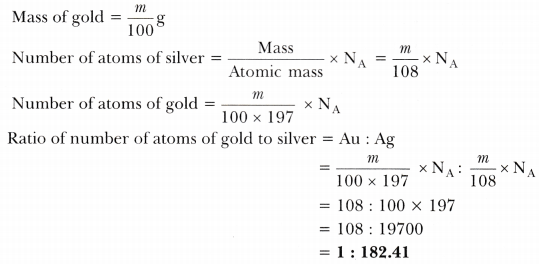
Question 14.
A sample of ethane (C2H6) gas has the same mass as 1.5 × 1020 molecules of methane (CH4). How many C2H6 molecules does the sample of gas contain? [NCERTExemplar]
Answer:
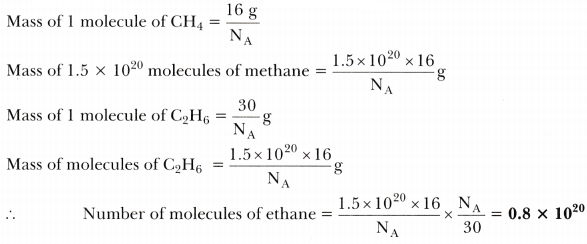
Question 15.
In photosynthesis, 6 molecules of carbon dioxide combine with an equal number of water molecules through a complex series of reactions to give a molecule of glucose having a molecular formula C6H12O6. How many grams of water would be required to produce 18 g of glucose? Compute the volume of water so consumed assuming the density of water to be lg cm-3.
[NCERT Exemplar]
Answer:
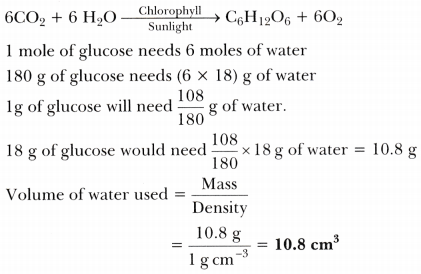
Question 16.
Calculate the ratio between the mass of one atom of hydrogen and mass of one atom of silver.
Answer:
1 mole of H atoms = 1 g
1 mole of H atoms = 6.022 × 1023 atoms.
Mass of 6.022 × 1023 atoms of H = 1 g
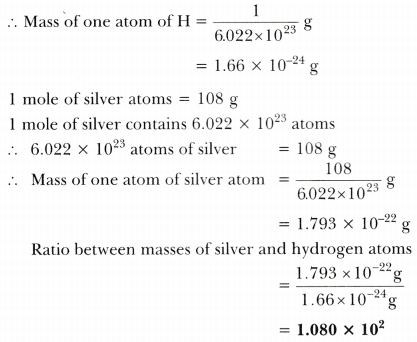
Atoms and Molecules Class 9 Extra Questions HOTS [Higher Order Thinking Skills]
Question 1.
A colourless liquid is thought to be a pure compound. Analysis of three samples of the material yield the following results.

Could the material be a pure compound?
Answer:
Analysis

Yes, the material is a pure compound as all the three samples have the same composition.
Question 2.
A big drop of water has volume 1.0 mL. How many molecules of water are there in this drop, If the density of water is lg/mL?
Answer:
Volume of drop of water = 1.0 mL
Density of water = 1.0 g/mL
∴ Mass of drop of water = Volume × Density = 1.0 g
Molecular mass of H2O = 2 × lu + 1 × 16u = 18u
Gram molecular mass of water =18 g/mol
18 g of water contains = 6.02 2 × 1023 molecules
∴ 1 g of water contains = \(\frac{6.022 \times 10^{23}}{18}\) molecules
= 3.34 × 1022 molecules
Question 3.
What is the fraction of the mass of water due to neutrons? [NCERT Exemplar]
Answer:
Mass of one mole (Avogadro Number) of neutrons ~ 1 g
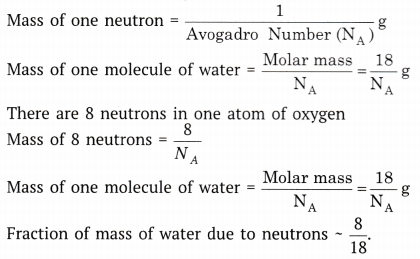
Question 4.
You are provided with a fine white coloured powder which is either sugar or salt. How would you identify it without tasting? [NCERT Exemplar]
Answer:
On heating the powder, it will char if it is a sugar.
Alternatively, the powder may be dissolved in water and checked for its conduction of electricity. If it conductsm it is salt.
Question 5.
Calculate the number of electrons present in 15.4 g of carbon tetrachloride (CCl4).
Answer:
Number of moles of CCl4 = \(\frac{\text { Mass of } \mathrm{CCl}_{4}}{\text { Molecular mass of } \mathrm{CCl}_{4}}=\frac{15.4 \mathrm{g}}{154 \mathrm{g}}\)
∵ = 0.1 mole
1 mole of CCl4 = 6.02 2 × 1023 molecules of CCl4
∴ 0.1 mole of CCl4 = 0.1 × 6.022 × 1023 molecules of CCl4
= 6.022 × 1022 molecules of CCl4
We know that one atom of carbon has 6 electrons and one atom of chlorine has 17 electrons. Therefore, one molecule of CCl4 will contain 6 + (4 × 17) = 74 electrons.
∴ Number of electrons in 6.022 × 1022 molecules of CCl4
= 74 × 6.022 × 1022 electrons
= 445.6 × 1022 electrons
= 4.456 × 1o24 electrons